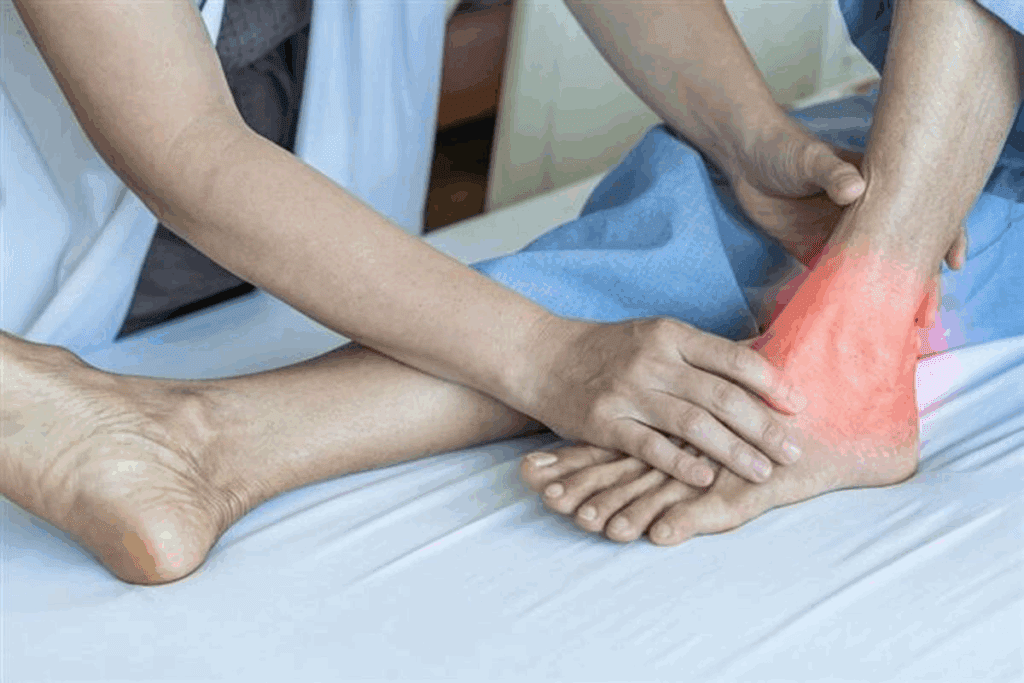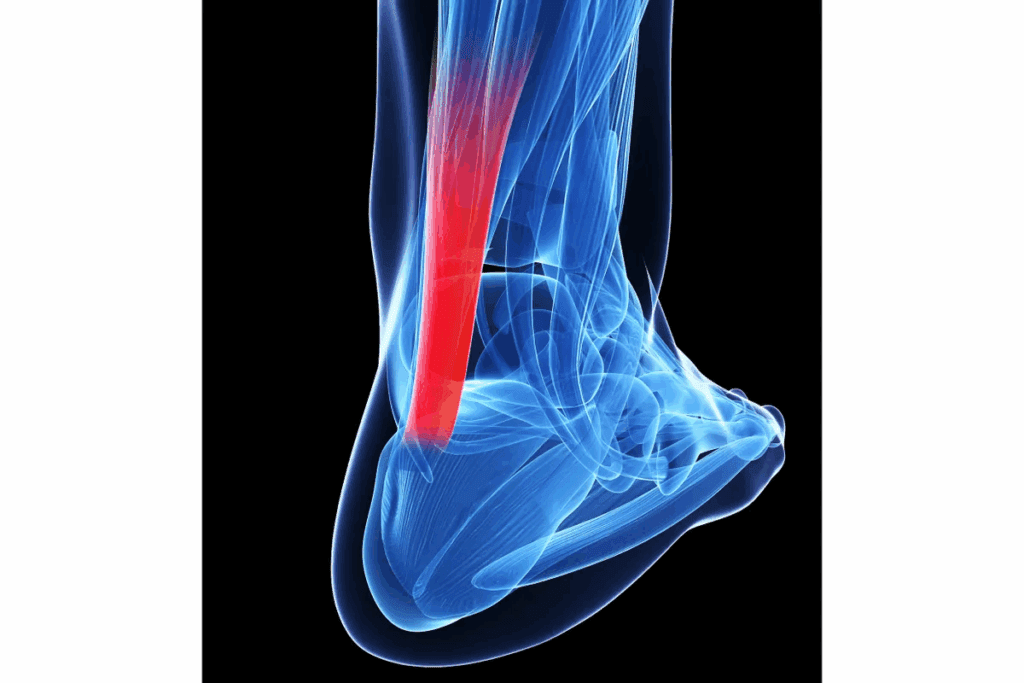
A sharp pain in the back of the ankle is often the first sign of an Achilles tendon issue. Many people feel a sudden, sharp sensation when they suffer a small tear. This can be quite alarming.
Understanding the sensations of a mild Achilles tear is key for early diagnosis and treatment. Discomfort may be felt during physical activities. Some individuals might notice a mild swelling or bruising in the affected area.
Key Takeaways
- Sharp pain in the ankle can indicate an Achilles tendon issue.
- A small tear can cause sudden discomfort during physical activities.
- Mild swelling or bruising may be visible in the affected area.
- Early diagnosis is key for effective treatment.
- Understanding the symptoms can help in identifying the issue.
Understanding the Achilles Tendon
Knowing about the Achilles tendon is key for treating injuries. These injuries are common in athletes and active people. The tendon helps us move by running, jumping, and climbing stairs.
Anatomy and Function
The Achilles tendon connects the calf muscles to the heel bone. It’s vital for moving our feet down, like when we walk or run. A strain in the Achilles tendon can hurt and make it hard to move.
The tendon is strong but can easily get injured because it doesn’t get much blood. Keeping it flexible is important, even more so for people with autism, as studies show.
Common Causes of Stress on the Achilles
Many things can stress the Achilles tendon, leading to soft tissue injury achilles. Overusing it is a big reason, like in athletes who run a lot. Other causes include:
- Poor footwear or training surfaces
- Sudden changes in exercise intensity or frequency
- Biomechanical issues such as overpronation or flat feet
- Aging, which can lead to tendon degeneration
| Cause | Description | Impact on Achilles Tendon |
| Overuse | Repetitive strain without adequate recovery | Increased risk of inflammation and injury |
| Poor Footwear | Inadequate support or cushioning | Additional stress on the tendon |
| Biomechanical Issues | Abnormal gait or foot structure | Uneven distribution of stress |
Knowing what causes stress on the Achilles tendon helps prevent injuries. By understanding these factors, we can keep our tendons healthy.
Types of Achilles Tendon Injuries

It’s important to know the different types of Achilles tendon injuries. This helps doctors diagnose and treat them right. The Achilles tendon can get inflamed, degenerate, or even tear.
Tendinitis vs. Tendinosis
Tendinitis is when the tendon gets inflamed, usually from too much use. Tendinosis is when the tendon wears down, but it doesn’t get as inflamed. Both can hurt and stiffen, but they need different treatments.
Partial Tears vs. Complete Ruptures
Achilles tendon tears can be either partial or complete. A partial tear only breaks some of the tendon. A complete rupture tears it all the way through. Tyrese Haliburton’s injury is an example of a complete rupture.
Partial tears hurt and stiffen, but the tendon stays connected. Complete ruptures hurt a lot and make it hard to move.
Grading System for Achilles Tears
The severity of Achilles tendon tears is graded from 0 to 3. Grade 1 is a small tear with little pain. Grade 2 is a bigger tear with more pain. Knowing the grade helps doctors choose the best treatment.
Getting the right diagnosis is key to treating Achilles tendon injuries. Doctors need to know if it’s tendinitis, tendinosis, a partial tear, or a complete rupture. This helps them treat it effectively and prevent more problems.
Small Achilles Tendon Tear Symptoms
It’s important to spot the early signs of an Achilles tendon tear, even if it’s small. A small tear can cause a series of symptoms. Catching these early can change how you treat and recover from the injury.
Initial Sensations and Pain Patterns
A small Achilles tendon tear might start with sharp pain or a mild ache above the heel. This pain gets worse when you run, jump, or change direction quickly. Tenderness in the Achilles tendon is another sign, making the area feel sore when touched.
Some people feel pain during movement, like walking uphill or climbing stairs. This pain might come and go, making it hard to know when to see a doctor.
Progression of Symptoms Over Time
As the tear gets worse, swelling with Achilles tear might show up. This swelling is usually right where the tendon is and might feel warm or red. Over time, the pain can stick around, making it hard to move or even do everyday things.
- Pain that worsens with activity
- Increased tenderness to the touch
- Swelling or thickening of the Achilles tendon
- Reduced ankle mobility
Watching these symptoms closely is key. Catching them early can help manage the injury better and might stop it from getting worse.
Pain Above the Heel: A Key Indicator
Pain just above the heel could mean trouble with the Achilles tendon. This is common in people who are active, like runners or jumpers.
Locating the Pain Precisely
The pain from Achilles tendon issues is usually found above the heel. It’s near where the tendon meets the calcaneus bone. Look for tenderness about 2-6 cm above the heel to find it.
Differentiating from Other Heel Pain Conditions
Pain above the heel can be mistaken for plantar fasciitis or heel spurs. But, Achilles tendon pain is higher and not on the heel. Knowing where and how the pain feels helps figure out what’s wrong.
It’s key to tell apart different heel pain issues for the right treatment. For example, heel pain might be from a spur, while Achilles tendon pain could be tendonitis or a tear.
Tenderness and Swelling in the Achilles Region
When the Achilles tendon gets hurt, you might feel tenderness and swelling. These signs show how serious the injury is. They are key for figuring out what’s wrong.
Palpation and Tenderness Assessment
Palpation is a way to feel with your hand. Doctors use it to check for tenderness in the Achilles tendon. It helps them find where and how bad the injury is.
Tenderness Assessment Steps:
- Gentle palpation of the Achilles tendon
- Identification of tender areas
- Assessment of pain response to pressure
Slight Swelling Patterns with Minor Tears
Minor tears in the Achilles tendon can cause slight swelling. This swelling is often tender and gets worse after you’ve been active.
The table below shows how swelling changes with minor Achilles tendon tears:
| Swelling Characteristic | Minor Tear | Significant Tear |
| Location | Localized to the tear area | More widespread along the tendon |
| Severity | Mild to moderate | Moderate to severe |
| Onset | Gradual, often after activity | Rapid, sometimes immediate |
Knowing about swelling and tenderness helps doctors figure out how bad an Achilles tendon injury is. Quick diagnosis is important for the right treatment and recovery.
Pain During Movement: When It Hurts Most
Achilles tendon pain often gets worse during specific movements or activities. This section looks at how different actions can make the pain from a small tear in the Achilles tendon worse.
Activities That Aggravate Symptoms
Certain activities can make Achilles tendon pain worse. These include:
- Running or jogging, specially on uneven or hard surfaces
- Jumping or quick changes in direction
- Climbing stairs
- Walking uphill
- Standing on tiptoes
These activities put more stress on the Achilles tendon, making the pain worse. Avoiding or changing these activities can help manage the discomfort.
Positions That Provide Relief
Finding positions that ease Achilles tendon pain is key for managing the condition. Some positions that may help include:
| Position | Benefit |
| Elevating the affected leg | Reduces swelling and pain |
| Resting with the foot in a neutral position | Minimizes stress on the Achilles tendon |
| Using orthotics or shoe inserts | Provides additional support and cushioning |
Medical professionals say, “Proper positioning and rest can greatly help with Achilles tendon injuries.” It’s important to talk to a healthcare provider to find the best treatment.
“Rest, ice, compression, and elevation (RICE) are initial steps in managing Achilles tendon pain.”
Weakness and Limited Function with Achilles Tears
The Achilles tendon is key for mobility. Injuries can greatly limit function. A tear can cause weakness and less function in the ankle.
Strength Deficits with Small Tears
A small tear in the Achilles tendon can cause noticeable strength deficits. This is because the tendon’s integrity is compromised. It can’t transmit forces from the calf muscles to the heel bone as well.
A study on professional athletes, like Tyrese Haliburton’s recovery, shows the big impact of Achilles tendon injuries. The rehab process focuses on getting strength and mobility back. This shows how important it is to tackle strength deficits early.
Impact on Daily Activities and Athletic Performance
Achilles tendon tears, even small ones, can greatly affect daily life and sports performance. Simple tasks like walking or climbing stairs can be hard because of pain and weakness.
For athletes, the effect is even bigger. Running, jumping, or quick changes in direction are hard. The table below shows how Achilles tendon tears can affect different activities.
| Activity | Impact without Injury | Impact with Small Achilles Tear |
| Running | Normal performance | Pain and reduced speed |
| Climbing Stairs | Minimal strain | Increased strain and pain |
| Jumping | Full capability | Reduced capability and pain |
Tightness and Stiffness in Achilles Tendon

The Achilles tendon is key for moving around. It can get stiff and tight, leading to pain. This stiffness often shows up in the morning or after rest.
Morning Stiffness Patterns
Morning stiffness in the Achilles tendon is common. This stiffness is often because the tendon gets less flexible when it rests. It’s important to know if this stiffness is normal or a sign of a problem.
Some people feel pain or tightness in the morning. This feeling gets better with gentle movement. Doing light stretches or gentle exercises can help.
Changes Throughout the Day
Stiffness in the Achilles tendon can change throughout the day. How active you are, your shoes, and your tendon’s health affect this. For example, doing hard activities can make stiffness worse.
It’s important to keep the Achilles tendon flexible. Regular stretching and strengthening exercises
Knowing these patterns helps spot problems early. It also helps keep the Achilles tendon healthy.
Soreness and Bruising with Minor Achilles Injuries
Soreness and bruising around the Achilles tendon can mean a minor injury. These injuries cause discomfort that can be managed with the right care and knowledge.
Post-Activity Soreness Patterns
Minor Achilles injuries often lead to soreness after activity. This soreness can feel like a dull ache or sharp pain. Running or jumping can make it worse, leading to more soreness after doing these activities.
It’s important to watch how sore you are. This soreness can tell you how serious the injury is.
Some key points to consider regarding post-activity soreness include:
- The soreness typically worsens with continued activity.
- Rest may provide some relief, but persistent soreness is a concern.
- Shockwave therapy may be considered for managing chronic heel pain associated with Achilles tendon issues.
Bruising Around the Achilles Tendon
Bruising around the Achilles tendon is another sign of a minor injury. This bruising happens because of tiny tears in the tendon. These tears cause bleeding into the surrounding tissues. Seeing bruising, along with pain, means something is wrong.
Key aspects to note about bruising include:
- Bruising may not always be visible immediately after the injury.
- The extent of bruising can vary, depending on the severity of the tendon damage.
- In some cases, bruising may be accompanied by swelling, further complicating the condition.
Understanding these symptoms is key for early detection and managing minor Achilles injuries. Recognizing soreness and bruising helps individuals take steps towards recovery and avoid further damage.
Diagnosing a Small Tear in the Achilles Tendon
To find a small tear in the Achilles tendon, doctors use both physical checks and imaging. Getting the diagnosis right is key for the right treatment and to avoid more harm.
Physical Examination Techniques
First, doctors do a detailed check-up to spot a small tear in the Achilles tendon. They use several methods to check the tendon’s health:
- Palpation: They feel the area around the Achilles tendon to find any tenderness or gaps.
- Thompson Test: This test checks if the foot can move down when the calf is squeezed. If it can’t, it might mean a tear.
- Range of Motion Assessment: They check how well the ankle moves to see if there’s stiffness or pain.
Imaging Methods for Confirmation
Even with physical checks, imaging is often needed to confirm a small tear. The most used methods are:
- Ultrasound: It shows the tendon moving and can spot tears, inflammation, and other issues.
- Magnetic Resonance Imaging (MRI): It gives clear pictures of the tendon and nearby areas. This helps see how big the tear is and if there’s more damage.
- X-rays: They’re not as good for soft tissue but can rule out other heel pain causes like bone fractures.
By mixing physical checks with imaging, doctors can accurately find small Achilles tendon tears. Then, they can plan the best treatment.
Differentiating Between Achilles Tendonitis and Tears
It’s important to tell the difference between Achilles tendonitis and tears. Both can cause pain and discomfort in the Achilles tendon. But, they are different in how severe they are and how they should be treated.
Overlapping Symptoms
Achilles tendonitis and tears share similar symptoms, making it hard to diagnose. You might feel pain, swelling, and stiffness in the tendon area. Pain is usually worse in the morning and gets better with activity, but comes back after rest or intense activity.
Swelling and tenderness are common, and the area might feel warm. Sometimes, you might hear a creaking or crackling sound when moving your ankle.
Key Differences in Presentation
Even though symptoms are similar, there are key differences. A tear causes sudden, severe pain and might sound like a snapping or popping sound. Tendonitis starts slowly, with pain getting worse over time.
The severity of the condition also varies. A complete tear can make walking very hard because of weakness. Tendonitis might hurt, but it doesn’t usually make walking as hard.
| Characteristics | Achilles Tendonitis | Achilles Tear |
| Onset of Pain | Gradual | Sudden |
| Pain Severity | Variable, often manageable | Severe, often debilitating |
| Swelling and Bruising | Mild to moderate swelling | Significant swelling and bruising |
| Functional Impairment | Pain during activity, but generally able to walk | Significant weakness, difficulty walking |
When to Seek Medical Attention for Achilles Pain
Tyrese Haliburton’s injury shows how important it is to get help fast for Achilles tendon problems. The Achilles tendon is key to our movement. If it gets hurt, it’s vital to treat it right away.
Red Flag Symptoms
Some signs mean you should see a doctor right away. These include:
- Severe pain that makes it hard to move
- Swelling or bruising around the tendon
- A popping or snapping sound when you get hurt
- Weakness or instability in your ankle
- Having trouble pushing off with your foot
If you notice any of these, you should see a doctor.
Preventing Progression to Complete Rupture
Getting help early can stop a partial tear from turning into a full rupture. You’ll need to rest, do physical therapy, and might need special shoes or inserts.
A study on Achilles tendon injuries stresses the need for quick diagnosis and treatment.
“Early diagnosis and proper treatment are key to managing Achilles tendon injuries well.”
To stop things from getting worse, you should:
- Stay away from things that make it worse
- Do physical therapy to make your calf muscles stronger
- Use orthotics or shoe inserts to ease the tendon’s stress
Knowing the warning signs and acting early can greatly lower the chance of your injury getting worse.
Treatment Options for Small Achilles Tears
Treating small Achilles tears often combines non-surgical and surgical methods. The choice depends on the tear’s size, the patient’s health, and their activity level.
Conservative Management Approaches
For small Achilles tears, non-surgical treatment is usually the first step. It aims to reduce pain, inflammation, and promote healing. Key parts include:
- Rest and Ice: Allowing the tendon to heal and using ice to lower inflammation.
- Physical Therapy: Exercises to strengthen the calf muscles and improve ankle movement.
- Orthotics and Supportive Devices: Using heel lifts or other devices to lessen stress on the tendon.
- Anti-inflammatory Medications: To control pain and reduce swelling.
When Surgical Intervention Might Be Necessary
Some small Achilles tears may need surgery, even after trying non-surgical methods. Surgery is considered if:
- The tear is large and non-surgical methods haven’t worked.
- The patient is young or very active and wants to return to activities quickly.
- There’s significant tendon wear or other issues.
Surgical options might include removing damaged tissue or repairing the tendon. Always talk to an orthopedic specialist before deciding on surgery.
It’s vital for patients to follow their healthcare provider’s advice. This helps choose the best treatment for their situation.
Recovery Timeline and Expectations
Understanding the recovery timeline is key when dealing with a small Achilles tear. The journey includes several stages, from the start of healing to full recovery. Each stage has its own milestones.
Healing Phases for Minor Tears
The healing of minor Achilles tendon tears can be broken down into three phases. First, there’s the inflammatory phase, which lasts a few days to a week. During this time, it’s important to rest the tendon and avoid activities that could make the injury worse.
Inflammatory Phase: This phase is marked by pain, swelling, and warmth around the tendon. It’s a critical time for the body to start healing.
Proliferative Phase: After the inflammatory phase, the body starts repairing the tendon. This is done through the production of new collagen fibers. This phase can last several weeks.
The final stage, the remodeling phase, is about strengthening and reorganizing the new collagen fibers. This can take several months. It’s during this time that the tendon gets stronger and more functional.
Milestones in the Rehabilitation Process
The rehabilitation for a small Achilles tear is a step-by-step process. At first, the focus is on reducing pain and swelling. As healing progresses, the goal shifts to strengthening the tendon and improving ankle mobility.
- Early rehabilitation (0-6 weeks): Focus on pain management, reducing inflammation, and initial strengthening exercises.
- Intermediate rehabilitation (6-12 weeks): Progressive strengthening, improving range of motion, and functional activities.
- Advanced rehabilitation (3-6 months): High-level strengthening, proprioceptive training, and preparation for return to sports or strenuous activities.
Tyrese Haliburton’s recovery from an Achilles tendon injury shows the expected recovery process for significant injuries. It highlights the need for patience and a well-structured rehabilitation program.
By knowing the recovery timeline and following a structured rehabilitation program, people with small Achilles tears can improve their recovery. This can also help prevent further injuries.
Conclusion
Knowing the signs of a small tear in the Achilles tendon is key. This knowledge helps in managing and preventing more harm. Early signs include pain above the heel, tenderness, and stiffness. These symptoms are important for achilles tendon care and preventing achilles injuries.
Getting a proper diagnosis and treatment is vital to avoid a complete rupture. Using rehabilitation can greatly help those with minor tears. It’s also important to manage achilles pain well. This helps in getting back strength and function.
Putting a focus on achilles tendon care and prevention can lower injury risks. This includes doing exercises for the calf muscles, wearing the right shoes, and slowly increasing activity. With the right steps, you can keep your Achilles tendon healthy and stay well.
FAQ
What are the common symptoms of a small Achilles tendon tear?
Symptoms include pain above the heel, tenderness, and swelling. You might also feel pain during movement, weakness, tightness, and stiffness in the tendon.
How does a small Achilles tendon tear feel like initially?
At first, it might feel like a mild discomfort or sharp pain in the back of the ankle. This can be mistaken for tendonitis or strain.
Can a small Achilles tendon tear cause pain during daily activities?
Yes, it can cause pain when walking, running, or climbing stairs. It can also cause pain even when you’re not moving.
How is a small Achilles tendon tear diagnosed?
Doctors use a physical exam and imaging like ultrasound or MRI to diagnose it. They check for tenderness and assess the damage.
What is the difference between Achilles tendonitis and a tear?
Tendonitis is inflammation, while a tear is a partial or complete rupture. Both can cause pain and stiffness, but a tear is more severe.
When should I seek medical attention for Achilles pain?
See a doctor if you have severe pain, swelling, or bruising. Also, if walking or standing on tiptoes is hard, it could be a serious injury.
What are the treatment options for a small Achilles tendon tear?
Treatment includes rest, ice, compression, and elevation. Physical therapy and sometimes surgery are also options.
How long does it take to recover from a small Achilles tendon tear?
Recovery time varies. It depends on the tear’s severity and treatment. It usually takes weeks or months of rehabilitation.
Can I continue to exercise with a small Achilles tendon tear?
It’s best to avoid activities that make it worse. Modify your routine to reduce stress on the tendon.
What are the possible complications of a small Achilles tendon tear?
Complications include a complete rupture, chronic pain, and limited mobility. Proper care is key to avoid these issues.
How can I prevent Achilles tendon injuries?
Wear proper footwear, stretch and strengthen your calf muscles. Gradually increase exercise intensity to avoid overuse.
Can tight calf muscles contribute to Achilles tendon problems?
Yes, tight calf muscles can stress the tendon, increasing injury risk. Stretching these muscles can help reduce tension.
References
- Maffulli, N., Longo, U. G., & Denaro, V. (2020). Achilles tendon rupture: Mechanisms of injury, principles of treatment, and long-term outcomes. Journal of Orthopaedic Surgery and Research, 15(1), 407. https://pmc.ncbi.nlm.nih.gov/articles/PMC7804867/



